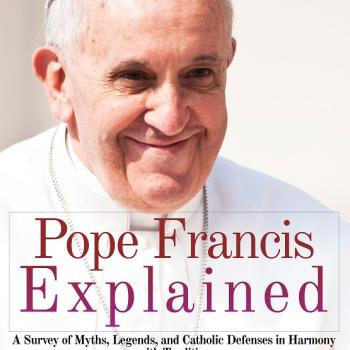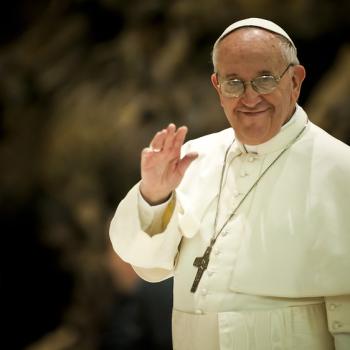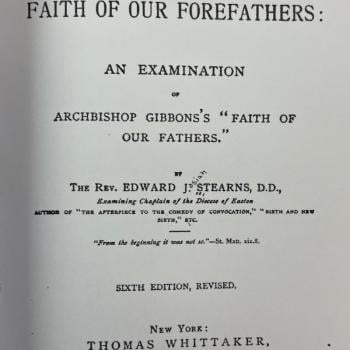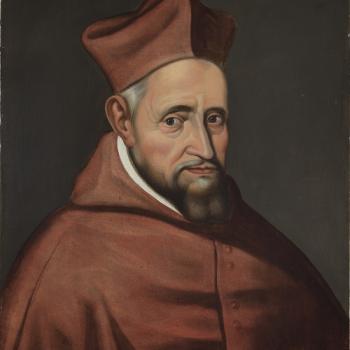
Timothy Flanders, writing in the reactionary venue One Peter Five (“Conspiracy and Catholic Doctrine: A Defense of Taylor Marshall”: 7-8-19), offers a rare substantive reply to any serious criticism of Taylor Marshall’s book, Infiltration. He deals with my first lengthy treatment of the book (technically not a book review): Reactionary Infiltration of Taylor Marshall’s Book, Infiltration (5-30-19).
He also counter-replies to Dr. Jeff Mirus (towards whom he is the most critical and disparaging), and Fr. Dwight Longenecker and Dr. Jennifer Roback Morse (both of whom he is relatively less critical of). So for once I’m not the biggest bum and scoundrel. I’m second fiddle to Dr. Mirus. The other three can all ably defend themselves. I will respond only to the critique of my article.
Timothy Flanders’ words will be in blue. Dr. Taylor Marshall’s words will be in green.
*****
To his credit, Armstrong engages in a somewhat academic manner by disputing some sources, but his critique also hinges not on a question of evidence, but on convicting Marshall of the sin of “bashing” so as to label him and dismiss him.
Flanders attempts to caricature my article as merely a species of “poisoning the well” and ad hominem attacks. This is, unfortunately, the usual response to any critique of radical Catholic reactionary thinking. I do indeed get into some of the evidence, both here and in many other articles, as I will explain further below, but this piece is primarily not a book review per se; rather, it is a piece of religious sociology. I make this quite clear in the first section of my lengthy paper. It could hardly be missed (yet Flanders did somehow manage to miss all that):
I will be examining its blatant reactionary aspects and simply citing from the book (what might be called “sociological exposing of extremist elements”) and identifying plain and obvious examples of three of the four classic hallmarks of radical Catholic reactionary beliefs:
1) Pope-bashing (I will concentrate on bashing of popes other than Pope Francis).
2) Vatican II-bashing.
3) Pauline / New / “Novus Ordo” / ordinary form Mass-bashing.
[the fourth common element is ecumenism-bashing, which is also assuredly a strong motif in the book]
I’ve applied this same method of analysis / exposure to several of the “statements” against Pope Francis and books or articles that criticized Pope Francis and also other popes, Vatican II, and the New Mass: [many papers of mine along these lines listed and linked] . . .
In other words, to sum it up: “It ain’t just Pope Francis.” It’s radical Catholic reactionary conspiratorial / alarmist / fanatical thinking (to more or less degrees, depending on the document). That’s why — increasingly — those who attack Pope Francis also are frequently observed attacking Pope Benedict XVI, Pope St. John Paul II, Pope St. Paul VI, and Pope St. John XXIII (even sometimes Ven. Pope Pius XII, too), and/or Vatican II, and/or the ordinary form Mass.
Armstrong is willing to state that his critique is “not personal,”
That’s correct, but of course, as with most criticism today, the recipients take it personally. This is just how it is in our postmodernist age, where everything is subjective, and dialogue becomes rarer and rarer . . .
but he ignores the salient points of Marshall’s work while attacking minor points.
As noted, my intent was not to address the cogency or factuality of every conspiracy brought up in the book, but to highlight only certain deliberately chosen motifs. These are not merely “minor points”: they are important aspects that need to be examined and scrutinized.
For instance, his treatment of Nostra Aetate ignores the fact observed by Marshall that the document’s first drafter was the erring theologian Gregory Baum, whose sordid life is now known. The issue is not whether the documents can be interpreted in an orthodox manner — they can — but whether they include intentional, weaponized ambiguity.
“Ambiguity” is standard / stock / playbook reactionary rhetoric: applied to Vatican II and Pope Francis alike. In the end, it is irrelevant who drafted a particular document. The Bible was largely written by terrible sinners as well (Moses the murderer, David the adulterer and murder, Solomon, who espoused false, idolatrous religions and likely died apostate, Matthew the tax collector, Paul the persecutor and murderer of Christians, and Peter, who denied Christ three times). But it is also inspired revelation, so God protected it.
All that matters in ecumenical councils is the final result, voted on by the bishops. That is what is protected by the Holy Spirit, from doctrinal error. And even Flanders admits that not only this, but all Vatican II documents “can be interpreted in an orthodox manner.”
And so, I am quite happy to discuss any of the documents with reactionary critics, to see whether in fact, a “heterodox” or “ambiguous” interpretation holds any water or makes sense. I did this in my section, “Vatican II Bashing.” I responded at some length to Taylor Marshall’s absurd charge:
Rahner introduced a new ecclesiology in which the Church of Christ is not the Catholic Church but rather “subsists in the Catholic Church.” This seems to contradict the teaching of Pope Pius XII in his 1943 encyclical Mystici Corporis . . .
I also dealt at length with the reactionary boilerplate that Vatican II was merely “pastoral” (a quick, easy, and dumb way to dismiss it). Moreover, not in this paper, but in others in the past month, I have directly taken on false charges against the alleged “ambiguity” or heretical teachings of various Vatican II documents:
The liturgical, theological, and philosophical changes of Vatican II . . . were detrimental to the laity.
. . . the modernizing and liberalizing tendencies in doctrine, politics, and liturgy of Vatican II.
Maritain proposed a “new form” of Christendom, rooted in his philosophical, political, and religious pluralism. In brief, it was a prototype for the ideals and goals of Vatican II.
The engineers of Vatican II were Karl Rahner, Edward Schillebeeckx, Hans Küng, Henri de Lubac, and Yves Congar. All five men were held under suspicion of Modernism under Pius XII. Karl Rahner, S.J. had a greater influence than any other on the theology Vatican II — so much so that one might say that Vatican II is simply Rahnerianism.
Devout Catholics often defend Vatican II by saying that it was “hijacked,” and that is certainly the case, but the question is when, and by whom. As will become clear, Pope John XXIII, and his favorites, Bugnini, Bea, and Montini [Pope St. Paul VI], had already set the optimistic new order, or novus ordo, agenda.
. . . he supported the reforms of the Second Vatican Council, . . .
His pontificate is clearly conflicted, . . . the Freemasons sought to create (beginning in the mid-1800s) a climate among youth, seminarians, and young priests who grew up breathing the air of ecumenism, indifference to religious disagreements, and a mission for world brotherhood. John Paul II is the first pope who moved freely in these ideals . . . he drank deeply of Vatican II, . . .
Some are convinced that John Paul II was not who we thought him to be.
It seems that what Mirus and Armstrong have done is attempt to swiftly silence any debate on this subject.
I’m all for constructive debate. I can’t find any significant follower of Taylor Marshall who is willing to do so. Nor is Dr. Marshall himself. I’ve critiqued him more than anyone else. But what has his response be so far?:
1) He blocked me on his Twitter page within 24 hours of the article under consideration.
2) He implied that my critiques were motivated merely by financial gain (“click bate” [sic] ).
3) He caricatured my critiques and those of the others above as merely ad hominem attacks or attacks on the publisher.
That’s some willingness to openly dialogue, isn’t it? Finally, after five weeks, at least one of Marshall’s defenders bravely ventures forth to deal with some of the critiques, but not Dr. Marshall himself, who remains missing in action.
Instead of discussing evidence, their critiques hinge on an unfortunate use of ad hominem: labeling Marshall’s work with a name — “conspiracy theory” — and asserting that an insult is sufficient to ignore evidence.
I made it clear that my purpose was not to discuss the various conspiracy theories in the book. I have no interest in them. I did mention one in passing, however:
The “Paul VI was a sodomite” conspiracy theory has been bandied about in many reactionary books and websites. By including it, Dr. Marshall “proves” to the reactionaries that he is definitely one of them. It takes a lot of hubris and chutzpah, indeed, to accuse a pope who is a saint — the very one who wrote the magnificently heroic, tradition-affirming Humanae Vitae at that — , of ongoing sodomy with a secret lover. To even mention such filth is a disgrace and an outrage.
As Fr. Longenecker’s review highlighted, I am not in the least opposed to the bare idea that the Church has been “infiltrated.” The question is in the details and facts and degrees. I didn’t really address this in my first long paper (here critiqued), but I did in my (censored) Amazon review, that was considered the “top review” for over two weeks, the top critical review, and the one that had the most “helpful votes” (over 250 before it was mysteriously removed. There I wrote, as the ending section:
Lastly, I agree that many groups have tried to infiltrate the Church. The radical homosexuals are the ones in our day. The liberals have been trying to wreck Catholicism since the French Revolution. My mentor, Servant of God Fr. John A. Hardon, SJ (who received me into the Church and enthusiastically endorsed my first book, A Biblical Defense of Catholicism) said often that modernism is the culmination of all heresies, and that the modernist crisis is the greatest in the history of the Church. I agree 100%!
My response to that, though, is that the Church is led and protected by the Holy Spirit and is indefectible; therefore, all such attempts fail in the long run. Reactionaryism is the counsel of despair. The orthodox Catholic is always hopeful and believes that God is in control and that all things work together for good (Romans 8:28).
Conspiratorialism is a dead-end street; the fool’s way out, and a plain dumb and intellectually naive and vacant interpretation of very complex events and ideas. Much better is traditional Catholic grace-empowered faith: particularly in the indefectibility of the Church, God’s providence, and the scriptural knowledge that sinners are always present in the Church (parable of the wheat and tares, seven churches of Revelation, etc.).
In this vision and way of life, we know and believe that God is always in control and protects Holy Mother Church despite our repeated attempts to bring it down to the dirt and filth of human sin and nefarious aspirations for power, rebellion against God, and all the rest.
I have not delved into all these conspiracies, since it was not ever my goal or intention, but a good friend of mine, Paul Hoffer (an attorney and Catholic apologist) has embarked on a multi-part point-by-point examination of the conspiracies suggested in Infiltration (three parts done thus far):
A Chapter-by-Chapter Refutation of Dr. Taylor Marshall’s Book, Infiltration: The Plot to Destroy the Church from Within (+ Part II / III) (Paul Hoffer, starting on 6-9-19)
Undoubtedly, they would have censured the great Dr. Dietrich von Hildebrand, Hammer of the Nazis, with the same unscholarly invective, since the latter was already talking about Freemasons in 1973. Indeed, reading Hildebrand shows exactly how inadequate ad hominem is in the shadow of this 20th-century giant.
Right. I have had about eight of his books in my library. I also talked at length with his wife Alice at a dinner party in 2000. And I guess this supposed hostility to Dr. Hildebrand is why I put out my article: Freemasonry? I’ve Had Links About it On My Site Since 2000 (I have vigorously opposed theological liberalism all this time, too) [6-5-19] I wrote in this paper:
I’m glad Taylor is educating Catholics about the danger of Freemasonry (including the infiltration of Catholic institutions). Welcome to the club, Taylor! I’ve been doing this for many years: as well as decrying theological liberalism from time immemorial (all the way back to 1982, as a Protestant apologist and researcher).
One can see my web page: “Theological Liberalism and Modernism (and “Dead” and “Nominal” Catholics)” in an archived version, dated 16 April 2000, filled with tons of links and many of my own articles on this dreadful error. Moreover, my book, Twin Scourges: Thoughts on Anti-Catholicism & Theological Liberalism dates from June 2003.
My concern and warnings about Freemasonry in particular have continued to the present time. On my site right now is the paper, “Catholic Refutations of Freemasonry (Collection of Links).” It is dated 6-28-10, back in the good ol’ days of Catholic unity, when Marshall still thought I was “one of the best cyber-apologists out there.” I added additional links on 9-26-16. It now contains 14 educational links.
The web page, “Liberal Theology & Modernism” is still there now, too.
So I have opposed this from the time before Taylor was even a Catholic [2006]. The difference is that I deny that Freemasonry has subverted an ecumenical council and popes. I think all such conspiracies to change the Catholic religion have failed. They’ve caused tons of damage to souls (I agree), but they haven’t succeeded in changing Church doctrine.
In conclusion, Flanders’ critique of my critique of Taylor Marshall scarcely deals with it at all. It ignores most of its stated purpose. But at least it is some semblance of an attempt (however weak and irrelevant). I’ll grant him that much. That’s already almost infinitely more than Taylor Marshall himself has done.
***
And of course, the combox savages me, as usual. I’ve already gone through this sort of silliness in the 17 or so days that my Amazon review was permitted to be publicly read on the book page. The comments were among the most ridiculous I have ever seen on any topic. The One Vader Five combox will likely soon surpass even that folly.
I posted a link to this paper in the combox, and it was allowed, but Big Cheese Steve Skojec showed up to lob his usual petty, small insults my way.
***
Photo credit: sunilkargwal (6-29-15) [Pixabay / Pixabay License]
***













